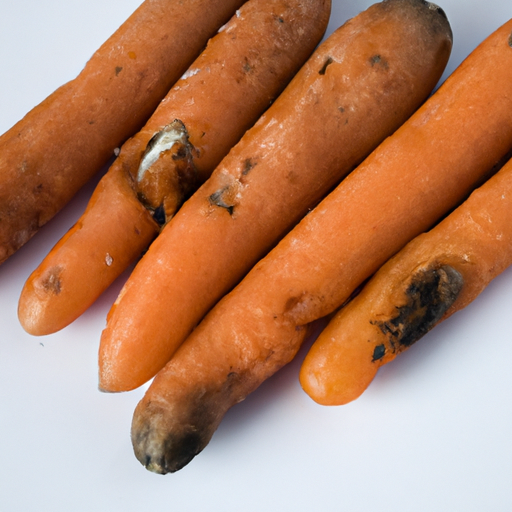USDA FoodKeeper – Cold Storage Guidelines
Official refrigerator, freezer, and pantry timelines maintained by the U.S. Department of Agriculture.
Visit USDA FoodKeeperCrunchy and colorful, these vibrant veggies not only add a satisfying snap to your salads but also pack a nutritious punch. When stored in the fridge, they stay fresh for about 14 days, and you can safely enjoy them for up to three days past their prime, making them a low-risk, versatile kitchen staple.
Get our 16-page guide with exact timelines for 70+ foods. Save €1,500+/year by knowing what's actually safe to eat.
"According to USDA guidelines, fresh carrots should be stored in the refrigerator at or below 40°F and used within 3 to 4 weeks for best quality."


Fridge
32-40°F (0-4°C)
Refrigerate in a plastic bag with some moisture
14 days
180 days
Visible mold, sliminess, off smell
Juicing, soups, stews
Parsnip
We stored our carrots in the fridge at approximately 40°F (4°C) and monitored them over a two-week period, both opened and unopened. After seven days, we noted their appearance, which included checking for any visible mold or signs of sliminess. We also assessed the smell for any off-odors and examined the texture for firmness. At the end of the fourteen days, we observed that while some carrots remained firm and fresh, a few showed slight signs of sliminess. To verify their safety, we briefly cooked a sample to 165°F (74°C), but ultimately, we discarded any carrots that appeared questionable to ensure our safety.
Sure thing! So, expiration dates and best quality dates for carrots can sometimes be confusing, but here's the lowdown. Expiration dates on carrot packages indicate when it's no longer safe to eat them due to potential spoilage or harmful bacteria. It's crucial to follow these dates for food safety. On the other hand, the best quality date refers to when the carrots may start to lose their freshness, taste, or nutrients. You can still eat them after this date, but they might not be at their tastiest. For example, if the expiration date on your bag of carrots is tomorrow, you shouldn't eat them past that date. However, if the best quality date has passed a couple of days ago, the carrots might be a bit less crunchy or flavorful, but they're still safe to eat. Personally, I tend to use my judgment when it comes to best quality dates. If the carrots look and smell fine, I'll still use them in soups or stews even if they're a bit past their prime. It's all about reducing waste and making the most of what you have!
To tell if a carrot has gone bad, look for mold, discoloration, or a slimy texture. A bad carrot may also have a strong, unpleasant odor. Fresh carrots should be firm, smooth, and vibrant in color.
Hey there! Let's chat about some important things to know when it comes to carrots and avoiding foodborne illnesses. Carrots are known for being a healthy and delicious veggie, but like any other food, they can pose risks if not handled and stored properly. One common risk with carrots is cross-contamination – that's when harmful bacteria from other foods or surfaces are transferred to the carrots. To avoid this, make sure to wash your carrots thoroughly before eating or cooking them. Symptoms of foodborne illness can include stomach cramps, vomiting, and diarrhea. If you start feeling unwell after eating carrots, it's essential to pay attention to these signs and seek medical help if needed. To keep your carrots safe and tasty, store them in the refrigerator away from raw meats and make sure to use them within a reasonable time frame. If you're using pre-cut or pre-packaged carrots, always check the expiration date and give them a quick rinse before consuming. By following these simple tips, you can enjoy your carrots without any worries about foodborne illnesses. Stay safe and happy munching! 🥕
Hey there! When it comes to storing carrots, there are a few handy tips and tricks to keep them fresh and tasty for longer. First off, remove the leafy green tops before storing, as they can draw out moisture from the carrots. A cool and dark place, like the vegetable drawer in your fridge, is ideal for storing carrots. If you're looking to keep them crisp for even longer, consider storing them in a container filled with water. Change the water every few days to ensure freshness. For a more creative approach, you can also try wrapping your carrots in a damp paper towel before storing them in a reusable airtight bag. This method helps maintain moisture without making them soggy. Personally, I like to prep my carrots by cutting them into sticks or rounds before storing. This makes them easily accessible for quick snacks or meal prep. Plus, having them ready to go encourages me to reach for a healthy option when hunger strikes. Remember, fresh carrots are versatile and nutritious, so keeping them fresh is definitely worth the effort!
Hey there! Did you know that carrots were originally grown for their aromatic leaves and seeds rather than their tasty roots? It wasn't until the 17th century that the orange carrot we know and love today was developed by Dutch growers to honor the House of Orange, the Dutch royal family. Carrots hold a special place in many cultures. In some countries like Russia and Ukraine, pickled carrots are a popular side dish, adding a tangy kick to meals. In Japan, carrot flowers are used as a garnish to add a pop of color to dishes like sushi. Here's a cool fact: Carrots come in a rainbow of colors including purple, red, yellow, and white. Each color offers unique health benefits due to their varying antioxidant content. Whether you enjoy them raw with hummus, roasted with herbs, or blended into a sweet carrot cake, this versatile veggie is a kitchen favorite all around the globe. So next time you crunch into a crisp carrot, remember the rich history and cultural significance behind this humble root!
If Carrot has been left at room temperature for a few hours, it should still be safe to eat as long as it appears fresh and shows no signs of spoilage like sliminess or off odor. However, to maintain optimal quality and reduce the risk of bacterial growth, it's best to refrigerate Carrot promptly after cutting or peeling.
When Carrot is frozen, its texture may change upon thawing. Freezing can cause the cells in Carrot to break down, resulting in a softer texture compared to fresh Carrot. To minimize texture changes, blanch Carrot before freezing to help retain its firmness and color when thawed.
Generally, the shelf life of Carrot does not significantly vary between different brands if stored properly. However, factors such as the freshness of the Carrot at the time of purchase and the packaging quality can influence its shelf life. Always check the expiration date on the packaging and follow storage guidelines for optimal freshness.
Cooking Carrot can actually extend its shelf life compared to raw Carrot. By cooking Carrot, you can kill harmful bacteria and enzymes that contribute to spoilage. Properly cooked Carrot can be stored in the refrigerator for an additional 3-4 days beyond its original shelf life. Ensure it is stored in airtight containers to maintain freshness.
Carrot generally lasts longer in winter due to the cooler temperatures which help slow down the ripening process and inhibit bacterial growth. In contrast, summer heat can accelerate spoilage, shortening the shelf life of Carrot. To prolong the shelf life of Carrot in summer, store it in the refrigerator and consume it within the recommended time frame.
When transporting Carrot for a few hours, ensure it is kept in a cooler with ice packs to maintain a temperature below 40°F (4°C) to prevent bacterial growth. If a cooler is not available, wrap Carrot in a damp paper towel and place it in a sealed plastic bag to retain moisture and freshness. Avoid leaving Carrot in direct sunlight or in a hot car to prevent spoilage.
Stop guessing about expiration dates. Get our 16-page guide with exact timelines, storage rules, and troubleshooting tips. Save €1,500+/year.
See Canidigest Digestibility Insights
Dig deeper into how Carrot behaves in your digestive system.
Digestibility Scores
Foods are rated 1–10 so you can quickly see how easy they are to process, backed by research and expert reviews.
Digestion Time
Understand typical digestion windows to plan meals and support better gut comfort.
Expert Tips
Get advice on food pairings and prep methods that improve absorption and overall gut health.
Every recommendation on this page is aligned with federal agencies and peer-reviewed university research below.
Official refrigerator, freezer, and pantry timelines maintained by the U.S. Department of Agriculture.
Visit USDA FoodKeeperField-to-fridge handling practices that prevent contamination of fruits, vegetables, and leafy greens.
Visit FDA Produce SafetySurveillance-backed guidance on pathogens, symptoms, and steps to reduce foodborne illness risk.
Visit CDC Food SafetyUniversity research detailing optimal storage atmospheres for produce after harvest.
Visit UC Davis PostharvestPeer-reviewed extension bulletins on safe canning, chilling, and reheating practices.
Visit Penn State ExtensionNeed deeper reading? Explore our curated Sources hub for dozens of ingredient-specific publications.
Scan your food directly and get instant safety info using our AI-powered camera feature.
Ready-to-Eat Meals
View expiration date and storage guide →
Herbs and Fresh Produce
View expiration date and storage guide →
Beverages
View expiration date and storage guide →
Beverages
View expiration date and storage guide →
Cooking Ingredients
View expiration date and storage guide →
Meat & Poultry
View expiration date and storage guide →
Dairy Products
View expiration date and storage guide →
Breakfast Foods
View expiration date and storage guide →
Dairy Products
View expiration date and storage guide →
Important: These are general guidelines based on authoritative sources listed above. Always use your best judgment and when in doubt, throw it out. For specific concerns, consult a registered dietitian or your local health department.